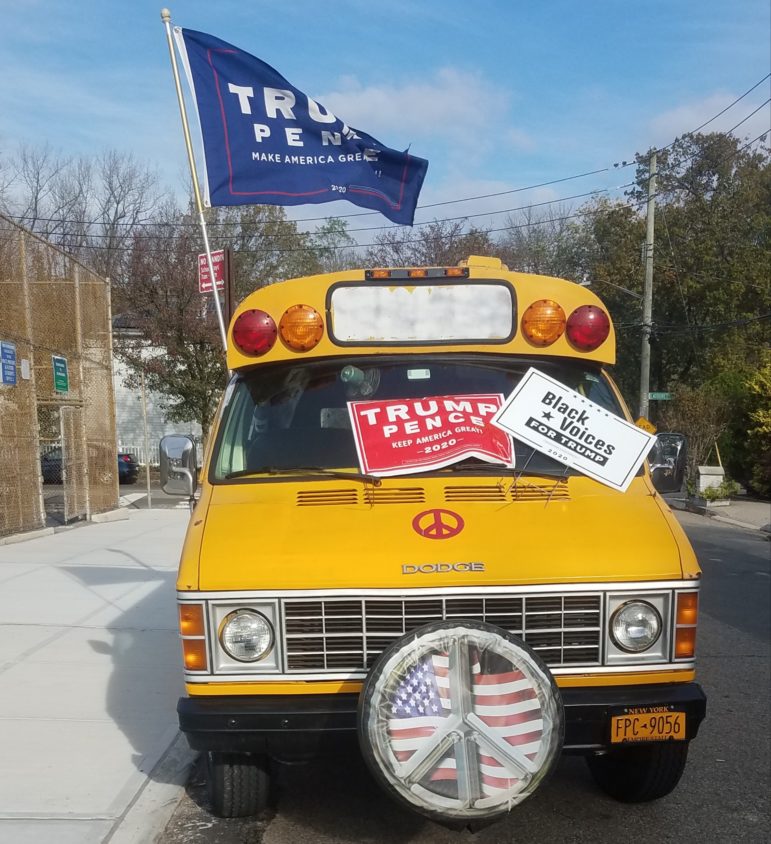
Jarrett Murphy
A bus decked out in Trump campaign signs seen outside PS.. 3 in Pleasant Plains, Staten Island.You don’t often see peace symbol decals and National Rifle Association stickers just inches apart on a compact yellow school bus flying a Trump 2020 flag and bearing a Black Voices for Trump placard. But you could see it Tuesday morning just down the street from P.S. 3, the Margaret Gioiosa School, in Staten Island’s Pleasant Plains neighborhood.
The man who identified himself as the van’s owner (he was white, by the way) stood nearby holding a Nicole Malliotakis for Congress sign. He was a few yards closer to the school, but still comfortably outside the 100-foot zone in which no electioneering is supposed to take place.
A voter wearing a MAGA hat, however, was well inside that zone when he walked into the school and down the steps to the gymnasium where supervisors Rosmarie Pagano and Luisa Rinaldi were keeping watch. They asked the man to remove his cap, apparently without incident. That is not always the case.
“I’ve had a few people come in with their Trump hats or T-shirts,” Pagano said. “I tell them, you’ve got to take it off.” One woman arrived with a Trump face-mask on; Pagano asked her to reverse it, and she did so without complaint. But when a man and his parents came in, the man refused to remove his Trump hat, disputing that there was any law against wearing election paraphernalia into polling site. “Where is that written?” he demanded, according to Pagano.
(In fact, it is written in New York State Election Law, chapter 5, section 205: While the polls are open no person shall do any electioneering within the polling place, or within a one hundred foot radial measured from the entrances, designated by the inspectors of election, to a building where the registration is being conducted. No political banner, poster or placard shall be allowed in or upon the place of registration during any day of registration. Where an oath is required or permitted by this article at any meeting for registration, any inspector may administer it. The inspectors, and each of them, shall preserve good order within and around the place of registration and keep access thereto unobstructed. The board or any member thereof by order in writing may direct the arrest of any person refusing to obey the lawful commands of the inspectors, or guilty of disorderly conduct disturbing their proceedings, or violating, or attempting to violate, any of the provisions of this chapter. Any police officer or peace officer, who is acting pursuant to his special duties, or any person designated by the board shall execute the order.)
Pagano brought over the police officer who was on duty, to which the angry MAGA man said, “I am a cop.”
“‘Well, then you ought to know better,’ I said. Keep in mind, I was very nice about it,” said Pagano, who indeed was very nice. The man said he would ask his dad what to do, which seemed odd, but defused the situation.
Democrats can be impolite as well. During a busy period earlier in the day she missed one MAGA hat and another voter complained. When Pagano tried to explain that she had not seen the hat, he did not accept the excuse. “He was nasty about it,” she says.
As 10 a.m. approached, Pagano characterized traffic as steady.
“We’re not getting choked,” she said. When polls opened at 6 a.m., three dozen voters were already lined up, packing the stairwell so tight she had to move them out to avoid creating a fire hazard. Pagano, who has been working elections since 1985 and supervising the site since 2001, said early voting was impacting turnout.
“This is definitely lighter. I mean, last time?” Pagano said.
“Forget it,” Rinaldi answered. “It was a madhouse.”
“They choked us to death,” Pagano continued.
Turnout patterns aside, the supervisors agreed that the replacement of paper address finders with tablets and the advent of the “fast pass” voter cards had made the job of election administration much easier.









